
How psychology works the facts visually explained (DK) (Z-Library)
.pdf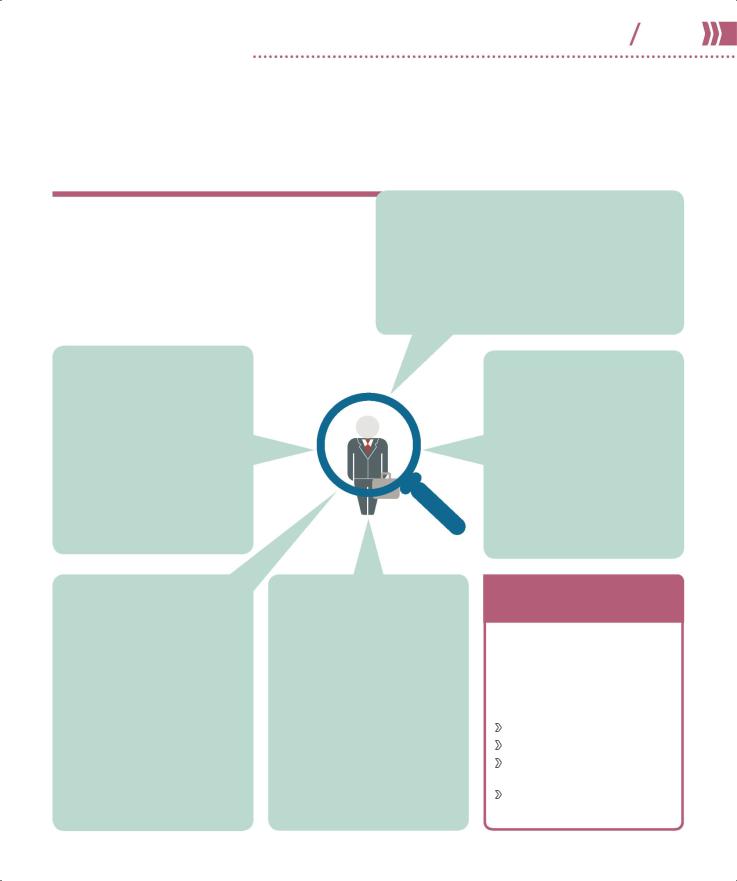
PSYCHOLOGY IN THE REAL WORLD |
178 179 |
Psychology in the workplace |
Talent selection
The ability to attract and retain the right people helps to make an organization great. If employees are well matched to their positions, they are more likely to be excited by what they are doing and the environment in
which they are working. Talent selection involves a set of procedures to determine how well job applicants
fit the job requirements. These are used alongside a standard job application, which asks questions about education, job skills, characteristics, and work history.
Assessment types
Five main techniques are commonly used for evaluating candidates, and often several of these are used together. These procedures reveal an applicant’s strengths and weaknesses in different areas, giving an organization valuable information about how a person might perform once employed.
WORK SAMPLE
A work sample is a simulation in which candidates perform part of a job, showing how well they can do relevant tasks under standardized conditions. They receive the necessary materials and tools, and instructions on how to complete the task. Work samples are good predictors of future performance because of the similarities between the assessment situation and the job.
BIOGRAPHICAL
INFORMATION
A biographical questionnaire asks for information about relevant prior professional and educational experiences. The questions are more detailed than those in a standard job application, and may include questions about specific experiences at school or work. There may also be questions about verifiable facts and subjective experiences.
INTERVIEW
The candidate’s answers and behavior in an interview both provide important information about their suitability for the job, as well as their ability to communicate and relate. Even eye contact or the firmness of a handshake can affect ratings. Most organizations use interviews because they allow candidates to give detailed responses and indicate their interpersonal skills.
ASSESSMENT CENTERS
In an assessment center, exercises and task simulations are used to measure how well a person can perform the job. Exercises are varied and can take several days to complete. Assessment centers evaluate candidates on the basis of oral and written communication, problem-solving, interpersonal relations, and planning. Candidates are scored on various dimensions and then given an overall score, which is useful for hiring decisions.
PSYCHOMETRIC TESTS
Candidates are often asked to take psychometric tests (pp.246– 247) under controlled conditions, involving problem-solving, answering questions, or tests of manual dexterity. They can evaluate personality, cognitive ability, knowledge and skills, emotional intelligence, or vocational interests. Questions can be closed-ended, with several possible responses to choose from,
or open-ended, in which test takers must generate their own responses.
INTERVIEW
RELIABILITY
Psychologists have found that interview accuracy is subject to the biases of the interviewer. Race, gender, and likability can all affect interview assessments and hiring decisions. Interviewers should:
Be trained to conduct interviews.Ask standardized questions.
Not evaluate the candidate until after the interview has ended.
Rate candidates on individual elements, such as qualifications.
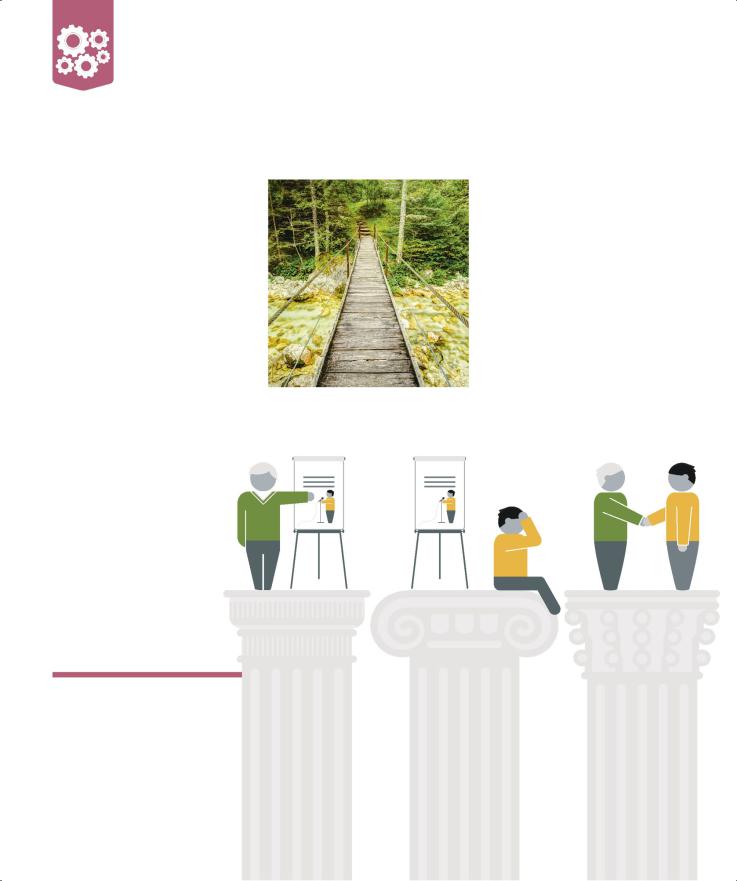
Managing talent
It is crucial for organizations to manage employee performance effectively to reach success. This can be achieved by implementing practices that increase motivation and regular feedback cycles.
Motivation
Often concerned with the desire to achieve a specific goal, motivation is an internal state that drives a person to carry out particular behaviors or tasks. People are motivated by many different things at work, including acquiring money, benefiting a social cause, and winning admiration. Employee motivation has been shown to be directly correlated with job satisfaction and job performance, and indirectly correlated with organizational success. If a person has the appropriate skill set, high levels of motivation generally lead to great performance at work, and this is essential to meeting an organization’s major goals.
Psychological theories of work motivation are concerned with the reasons why some people are motivated to perform their jobs better
than others, and they allow management to see what they need to provide to maximize motivation and
HAVING A CAREER PATH is more likely to motivate an employee to perform well due to feeling their efforts will be rewarded.
GOAL |
GOAL |
performance. Need hierarchy theories hold that a person’s behavior is directed toward fulfilling their needs, and that their motivation is generated internally. Reinforcement theory assumes that behavior arises from the desire to earn rewards and reinforcements, and so is generated externally. Self-efficacy theory examines how people’s belief in their own abilities can affect performance, and goal-setting theory explains how people’s goals and the ways in which they are set can affect their motivation and performance.
Setting goals |
Clarity |
Challenge |
Commitment |
|
Goals must be |
Tougher goals |
Goals must be |
||
|
||||
In the 1960s, Dr. Edwin Locke |
clear, specific, and |
are often more |
understood and |
|
pioneered the goal-setting |
measurable, with |
motivating |
agreed upon by |
|
theory of motivation, which |
unambiguous |
because people |
both employer |
|
states that working toward a |
deadlines, so |
anticipate greater |
and employee. |
|
goal increases motivation |
employees know |
rewards. However, |
This makes an |
|
and performance. He found |
what is expected |
the goal must not |
employee more |
|
that specific and challenging |
of them and when. |
be so challenging |
committed to |
|
goals work most effectively. |
|
that it is unrealistic. |
achieving them. |
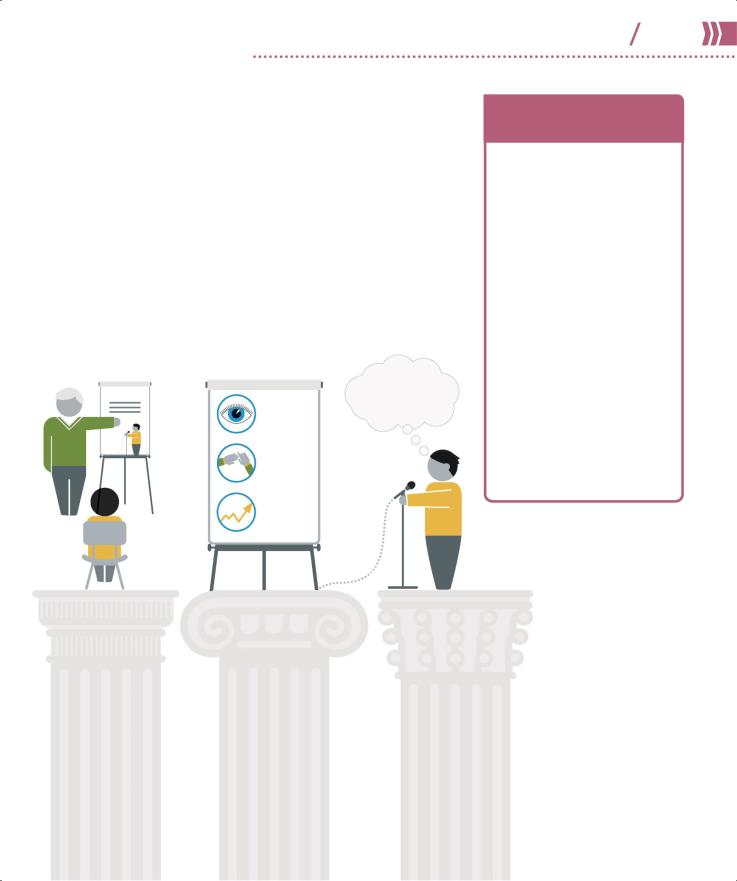
PSYCHOLOGY IN THE REAL WORLD |
180 181 |
Psychology in the workplace |
Performance appraisal
Offering employees feedback on their performance helps motivate them to achieve their goals, allows for the acknowledgment of good work, and provides an opportunity to give them constructive criticism and guidance if their performance is low. A performance appraisal is a two-step process that includes first defining the criteria for
good performance, and then implementing a performance
appraisal procedure. It can benefit the organization as well as the employee, providing information that contributes to administrative decisions (such as hiring and firing) and employee development, which is necessary for improving and maintaining job performance over time. Organizations often have an annual appraisal structure that includes goal setting and periodic feedback sessions between the employee and the supervisor.
GOAL |
|
GOAL |
|
ACHIEVED |
|
|
EYE |
|
|
|
|
|
CONTACT |
|
|
BODY |
|
|
LANGUAGE |
|
|
DELIVERY |
|
|
SPEED |
|
OVERCOMING RATING BIASES AND ERRORS
Human judgment is imperfect, and when supervisors make performance ratings, they often unintentionally exhibit biases and errors. Studies have found that ratings can be affected by how well a supervisor knows and likes an employee, by the employee’s overall mood, and by cultural and racial factors. Supervisors can also be subject to the halo effect, in which they give an individual the same rating across all appraisal dimensions, as well as the distributional error, in which they give the same ratings across all their supervisees. To overcome these problems, organizations can give supervisors rater training designed to show them the typical errors to avoid. In 360-degree feedback, more than one person rates an employee, to reduce the effects of individual biases.
Feedback |
Task complexity |
Achievement |
Regular progress |
Success depends |
The conditions for |
reports are crucial |
on whether the |
success are met |
for clarifying |
goals can be |
when a goal is |
expectations, |
completed in the |
clear, challenging, |
adjusting the |
time frame agreed |
and appropriately |
difficulty of goals, |
upon. Employees |
complex; |
and recognizing |
need time to learn |
commitment is |
employee |
the skills required |
high; and feedback |
achievement. |
to meet their goals. |
is regular. |
60%
of employees would like their work
to be praised more often
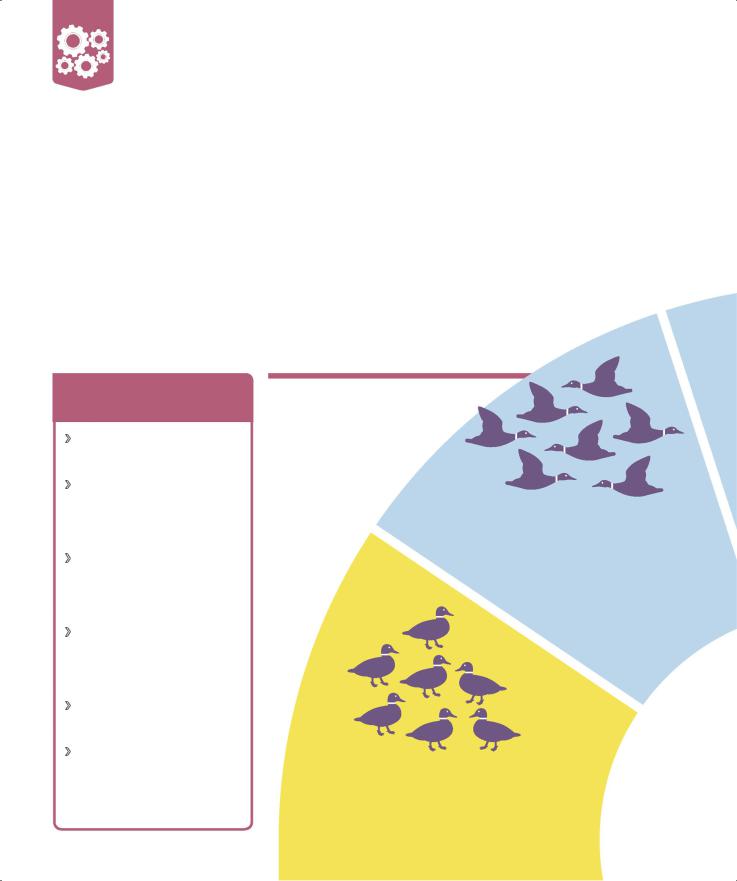
Team development
Work teams can be dynamic and powerful and help organizations thrive. There are many ways of developing the strengths, effectiveness, and potential of people working in groups and of groups as a whole.
How it works
Teamwork offers the advantages of group performance, which is often better than individual performance because the strengths of every team member combine to create something more effective than can be achieved alone. In a successful team—a group of surgeons performing a complex operation, for example—the actions of every
member are coordinated and oriented toward achieving a common goal. Each member has a specific role, but all members are interdependent, relying on each other to perform their jobs well. This level of cooperation requires trust, which can be built through good communication, competence, commitment, and collaboration. However, not all teams perform as
well as they should, an outcome that is called process loss. This may occur due to social loafing, when people expend less effort as part of a team than they would if working alone (pp.240−241), and impaired brainstorming, when a group generates fewer ideas than are produced by the same
number of people on their own.
KEY CONCEPTS
FOR TEAMS
Role Every team member has a distinctive and discrete job within the team.
Norms Certain unwritten rules of behavior (such as how late people work) are accepted by team members and strongly affect individual behavior.
Group cohesiveness A sense of unity and trust, among other variables, brings team members together and enables them to continue working together.
Team commitment An individual’s acceptance of team goals and willingness to work hard reflect the strength of their involvement with the team.
Mental model A good team has a shared understanding about the task, equipment, and situation.
Team conflict Whether teams are cooperative or competitive as they attempt to deal with clashes determines how effective they are.
Five-stage model
Psychologist Bruce Tuckman presented five stages of team development necessary
for growth. Progressing through these stages allows teams to face challenges and
find solutions together.
The birds take off and establish their flying positions.
2. Storming
In the early stages of working together, team members compete with each other for status. Differing opinions about what should be done, and how, can cause conflict.
Migrating birds must work as a team to ensure they survive their long journey.
1. Forming
The team members meet each other. They share information about themselves, learn about the project and their roles in it, and establish ground rules for working together.
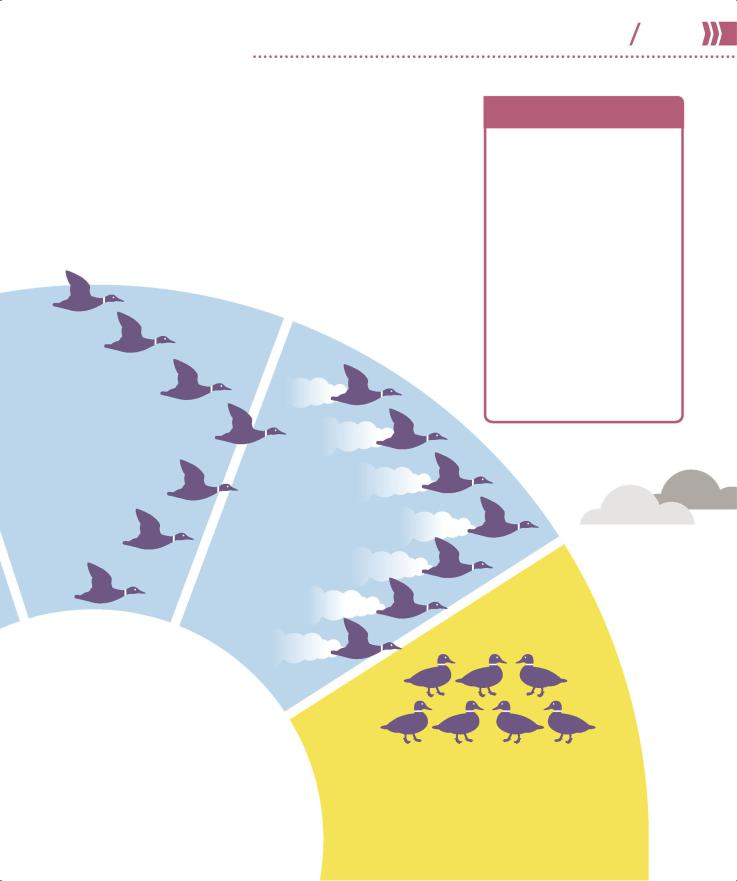
PSYCHOLOGY IN THE REAL WORLD |
182 183 |
Psychology in the workplace |
Improving teams |
deeper insight into issues facing |
|
Several techniques can be used |
the group. Colleagues can also take |
|
to improve teamwork. Creating |
part in team-building activities, |
|
autonomous work teams that are |
which are often led by an expert |
|
responsible for a particular product |
consultant. Some activities aim to |
|
or process can improve efficiency. |
strengthen the team’s ability to |
|
Some companies create quality |
perform a task, while others focus |
|
circles, where groups of employees |
on interpersonal skills, helping to |
|
meet to discuss problems and |
improve trust, communication, and |
|
propose solutions, giving them |
interaction. Team building aims to |
|
|
result in better team coordination |
|
|
and performance, enhanced skills |
|
|
for individual team members, and |
|
The birds fly in a |
more positive attitudes |
|
within the team as |
||
V formation with |
||
those at the top |
a whole. |
|
working hardest. |
|
3. Norming
Members begin to feel part of the team. They are less focused on individual goals and more focused on working together effectively, creating processes and procedures.
The birds swap places regularly, taking turns at the front.
4. Performing
The team is functioning at a high level, with members collaborating and creating an open and trusting atmosphere. They rely on
each other and are focused on achieving group goals.
GROUPTHINK
When people work together in groups, their decision-making process can be compromised by groupthink, a phenomenon in which groups make decisions that individual members know are bad. Groupthink is likely to occur in highly cohesive groups with strong leaders and a strong pressure to conform. People put aside their own perceptions and rationalize their doubts in order to fit in with other members. If the group is isolated from outside influences, and no one in the room is willing to challenge the leader, the chance of groupthink increases. To prevent this, leaders should act as impartial moderators in group meetings.
On arrival, the birds scatter in search of food.
5−9
is the ideal number of members for a successful team
5. Adjourning
As a project nears completion, the team conducts an assessment of its work, celebrating successes and seeing what can be improved. Team members say goodbye and go on to new projects.
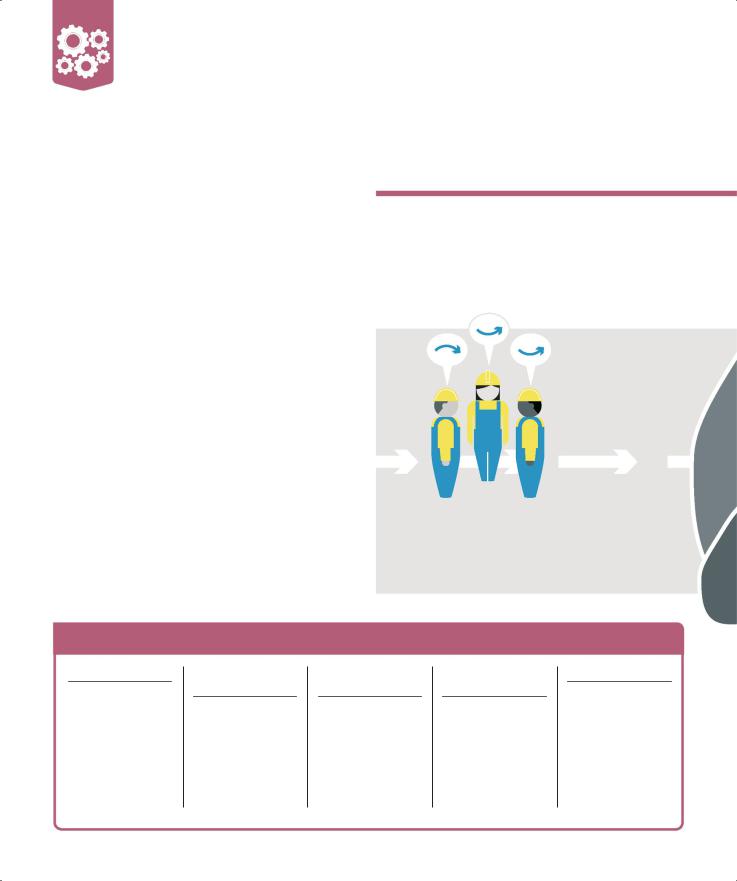
Leadership
Leaders are highly influential within their organization, and their approach can affect productivity and success. Good leaders use their knowledge and authority to inspire and motivate employees.
Types of leader
Leaders influence the attitudes, beliefs, behaviors, and feelings of other people, and their leadership style forms the basis of team dynamics. There are two main types of leader in the workplace: formal leaders who occupy supervisory roles, and informal leaders—often the more influential type—who emerge from groups through interactions with colleagues.
Informal leaders can possess expert power, based on perceived expertise, and referent power, which is granted because subordinates like and identify with the leader. Formal leaders may have additional types of powers. Legitimate power is inherent in a supervisor’s job title, while reward power allows leaders to praise employees and grant pay increases and promotions. When leaders discipline employees through salary reduction or firing, they are using coercive power.
Good leaders use power appropriately, showing concern for the welfare of subordinates, and providing structure by setting clear expectations. They can be identified by psychologists and companies using the trait approach (pp.150–151) (specific traits make them natural leaders), the leader emergence approach (they are singled out from within groups for their leadership potential), or the leader behavior approach (what matters is not who they are, but what they do).
Path-goal theory
Developed by Robert House, this model is designed to help supervisors enhance their employees’ job performance by making it easier for them to complete tasks and achieve goals. Leaders can adopt one of four different styles to match the employee, the environment, and the goal.
SETTING A CHALLENGE
Achievement-oriented leadership is the best approach for highperforming subordinates facing complex tasks.
Achievement
Achievement-oriented leaders set challenging goals, and both demonstrate and expect high standards. They show faith in their subordinates.
QUALITIES OF GREAT LEADERS
Strong ethics
An ethical leader models and expects honesty across the company, and their strong ethics create a safe and trusting
environment in which employees can do their best work.
Empowering others
No leader can do everything alone, and having external input is highly valuable;
so it is important for leaders to delegate work and to distribute power.
Fostering a sense of belonging
People spend a lot of time at work, so need to feel connected to the organization and to coworkers in order to improve emotional well-being and productivity.
Openness to new ideas
Progress requires innovation and a willingness to solve problems. A leader who is open to new ideas creates an environment in which progress is possible.
Nurturing growth
People are most motivated when they are encouraged to develop. Leaders who commit to fostering growth end up with more motivated and
loyal employees.
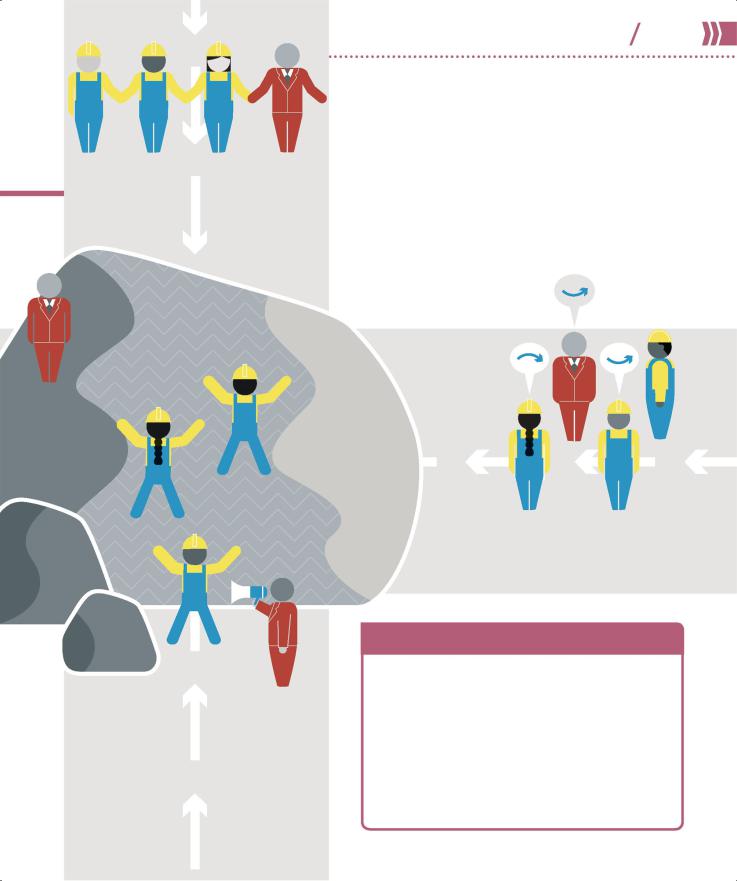
Supportive
Supportive leadership is characterized by considering employees’ needs, showing concern, and creating an encouraging work environment.
PSYCHOLOGY IN THE REAL WORLD |
184 185 |
Psychology in the workplace |
HAND-HOLDING
Supportive leadership is the best approach when the task is dangerous, tedious, stressful, or boring.
“The key to successful leadership today is influence, not authority.”
Ken Blanchard, American management expert
ASKING ADVICE
Participative leadership is the best approach to use when advice from experienced subordinates
is needed.
Participative
Participative leaders consult with subordinates, and take their ideas and suggestions into account when making decisions.
Directive |
GIVING ORDERS |
|
Directive leaders tell |
Directive leadership |
|
is the best approach |
||
subordinates what |
||
for inexperienced |
||
must be done and |
subordinates, |
|
offer appropriate |
especially if they |
|
guidance, such as |
are carrying out |
|
unstructured tasks. |
||
schedules and |
||
|
||
deadlines for them |
|
|
to work toward. |
|
TRANSFORMATIONAL LEADERSHIP
Some leaders are unusually effective at motivating others to join a cause, adopt a set of goals, and work persistently toward high achievement. These leaders are charismatic and capable of great influence. They inspire others with their creativity, power, innovative spirit, trustworthiness, and shared vision. They earn trust by prioritizing employees’ development and well-being, and in this way, they build
a loyal, motivated, and high-performing team. As with political leaders and activists such as Martin Luther King Jr., charisma and vision are important qualities that an individual needs to become a transformational leader.

Organizational culture and change
One of the most important building blocks for a thriving organization, culture consists of shared beliefs and behavior. To be productive it may need to change to accommodate new people, ideas, and technologies.
Culture
Organizational culture is how employees make sense of their workplace and one another, and it contributes to the organization’s unique social and psychological environment. Culture is defined by the values and rituals that unite work teams, and by consistent
and observable patterns of behavior. It encompasses the organization’s norms, systems, language, assumptions, visions, and beliefs, and directly influences how organizations treat people, make
decisions, and ensure commitment to projects. Culture is also shaped by leadership, and the incentive and compensation structures that are in place.
Organizational change is not easy to implement because of people’s ties to culture, but it becomes necessary when existing structures and processes no longer effectively meet requirements or achieve goals. Attachments to psychological contracts (the unspoken expectations of employees) can also cause resistance to change because it remolds these expectations.
Making changes
Successful change takes place in several stages and needs to be presented with compelling arguments. Helping anxious employees understand why change is needed can reduce their resistance during implementation and speed their acceptance of the new structure and processes.
1. Evaluate
Carrying out an evaluation of the organization’s current status is the first step toward change. This will help determine which systems and processes are not performing well, and so establish the main areas for improvement.
2. Assess
An assessment will examine the overall scope of the change, such as how many employees will be affected, as well as the type of change that is needed. Success relies on the participation of the people whose daily work lives will change.
THE PROBLEM
Assessment is vital in planning change. A new bridge must be strong enough to withstand both the river and the traffic.
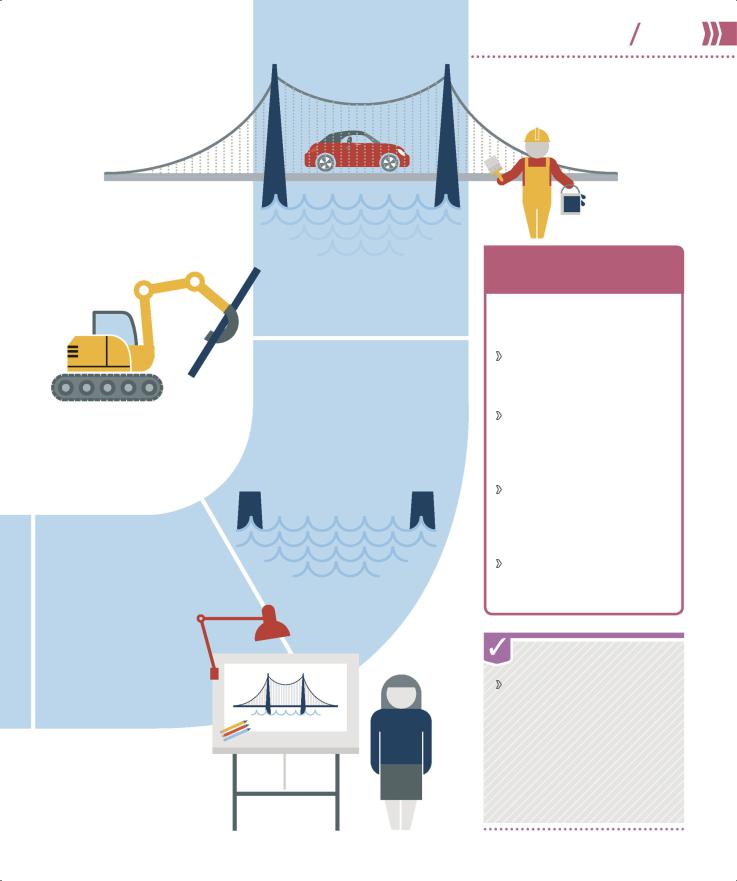
TOOLS
The right tools are needed to build a new structure. Training programs, financial incentives, and even threats can be used to get employees to cooperate.
3. Design
A structure that meets the requirements of the organization’s new strategies and goals will be designed. This design will identify key activities, create new departments, and establish interdepartmental relationships.
PROCESS
It takes time to design a new structure, and change does not happen all at once. The process takes place in several stages, usually with the help of an external change agent.
5. Manage change
Leaders should be attuned to how employees react to change, addressing issues as they arise and assessing how successful implementation has been.
4. Implement
Applying change in stages will make the transition smoother for employees who will often resist change. An organization should communicate well and make people feel involved so that the new ways of operating will eventually become accepted.
186 187
AFTER CHANGE
Managers should assess continually how well a new structure is working, and make repairs as necessary.
GUIDELINES TO FACILITATE CHANGE
Various steps can be taken to help employees cope with organizational change.
Strong leadership Managers should show their support for the change to bolster the enthusiasm of subordinates.
Employee involvement
Members of staff should be included in the decision process to feel a greater sense of ownership.
Communication The specific nature of the change should be communicated in a systematic and structured way, as should its implementation and timeline.
Celebration Every success should be celebrated throughout the process to build positivity.
NEED TO KNOW
Kaizen A common organizational goal is to establish kaizen, a system that originated in Japan, in which continuous improvement is possible. Employees at all levels are asked on a daily basis to suggest improvements, the aim being to get rid of unnecessary tasks and increase productivity.

HFE psychology
HFE (human factors and engineering) psychology is devoted to helping people cope better in their work environment, making it safer, more productive, and more user-friendly. At its essence is the study of how people interact with machines and technology, and the formulation of ways to improve these interactions by designing better systems, products, and devices. Positioned at the crossroads
of psychology and technology, HFE psychology is primarily focused on safety.
HFE in practice
On a practical level, HFE psychologists use their knowledge of how people interact with machines to design more effective work practices and products. This entails studying how a person’s mind, reflexes, vision, and other senses function in particular settings, from the factory floor to
a hospital operating theater. By studying people’s workplace behaviors, HFE psychologists can advise business decision-makers, industrialists, and governments on strategies for avoiding accidents and enhancing productivity.
One key application of this psychology is commercial aviation, an industry that has been using HFE since the 1960s to improve airline safety statistics. Eliminating mortality due to human error in hospitals is another focus, as
is reducing risk in critical operations such as the supply of nuclear power. Even the humble bicycle has benefited, becoming faster, easier to use, and more comfortable thanks to HFE psychology.
|
|
LIFE FAC |
TO |
|
|
|
|
L- |
|
R |
|
||
EA |
|
|
|
S |
||
R |
|
|
|
|
|
|
HUMAN |
|
|
EQUIPMENT |
|||
TRAITS |
|
|
|
DESIGN |
||
Assessing people’s |
|
Engineering |
||||
physical, |
|
|
technology to fit |
|||
perceptual, and |
varying body |
|||||
psychological |
|
|
heights and |
|||
abilities |
|
|
|
proportions |
||
SOCIAL |
|
|
|
|
|
WORKING |
ORGANIZATION |
|
|
|
|
|
ENVIRONMENT |
|
|
|
|
|
|
Safety awareness; |
|
|
|
|
|
|
controlling lighting |
|
|
|
|
|
|
and temperature to |
|
|
|
|
|
|
optimize alertness |
TASKS AND |
|
TRAINING AND |
||||
FUNCTIONS |
|
DEVELOPMENT |
||||
Studying people’s |
Training people to |
|||||
work activities and |
get the most from |
|||||
their interactions |
the equipment and |
|||||
with technology |
systems they use |
|||||
